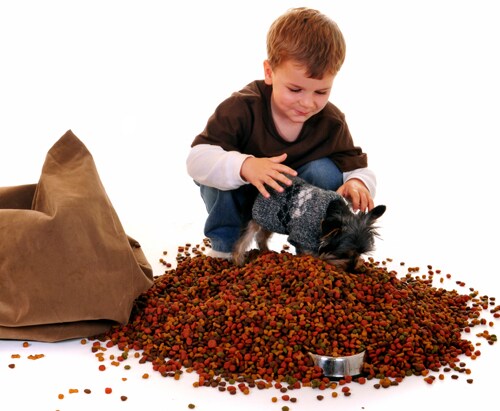
According to a recent study by the American Academy of Pediatrics (AAP), feeding the family pet is one of the main causes of Salmonella poisoning in toddlers. From January 2006 through October 2008, a Salmonella outbreak that was eventually linked to a pet food manufacturing plant in Pennsylvania sickened a total of 79 people across 21 states where the food was distributed. Out of the 79 reported cases of Salmonella poisoning that had been traced to the dry pet foods, 32 of the diagnosed patients were children under the age of 2. The plant has since been closed down due to insufficient findings as to the cause of the contamination. The specific strain of this food-borne illness is Salmonella Schwarzengrund, an uncommon strain.
Although the outbreak had been previously investigated and reported to the public by the Food and Drug Administration (FDA) and the Centers for Disease Control (CDC), there had not been a comprehensive report on the dangers of dry pet foods and the risk of contamination for pet caregivers, children in particular.
While direct contact with contaminated food is the main concern, and appears to be the main vector for transmission of the bacteria, the CDC and AAP reports also detail the high incidence of infection in homes where pets were fed in the kitchen. The presumption is that in some homes there was a cross contamination of the foods with other sources in the kitchen, possibly stemming from the animal’s food bowls being cleaned in a manner that was not sanitary (i.e., in a sink that was also used for human food dishes).
The AAP is working to determine the reasons behind why very young children appear to be at an increased risk, but so far the hypothetical reasons are the tendency for young children to eat pet food, their proximity to the floor, and by association, the food bowls, and an immature immune response. Symptoms of Salmonella poisoning include bloody diarrhea, fever, and stomach pain. There have been no deaths in relation to pet food related Salmonella poisoning.
While the main focus is on safe handling practices with pet food bowls and bagged, dry pet foods, the CDC has also confirmed cases in which packaged pet treats have been found to be contaminated with various strains of Salmonella. While much of the focus has been pointed toward the youngest patients, it is, of course, important to note that they made up just under half of all confirmed cases. All ages are at risk for illness due to Salmonella poisoning.
All concerned health agencies have cautioned against over reacting to the possibility of contaminated pet foods, but do stress the importance of safe food handling.
Some of the basics listed by the FDA and CDC include:
- Always washing hands with warm, soapy water after handling pet foods and treats, and especially before preparing, serving, or consuming food, baby bottles, and drinks.
- If possible, pets should be fed in a location other than the kitchen/food preparation area.
- When possible, pet food dishes should not be cleaned the main sink or bathtub. If it is necessary to use the main sink or bathtub, sanitize it after the pet food dishes have been cleaned and removed.
- Risk of cross-contamination suggests that infants and small children not be bathed in the kitchen sink.
- Children under the age of 5 should not be allowed to have contact with pet foods or treats.
- Pet foods should be stored in closed containers, out of the reach of children.
Learn more pet food safety tips and precautions here:
CDC – Safe Handling and Storage of Dry Pet Foods
FDA – Safe Handling Tips for Pet Foods and Treats
Source: PetMD
